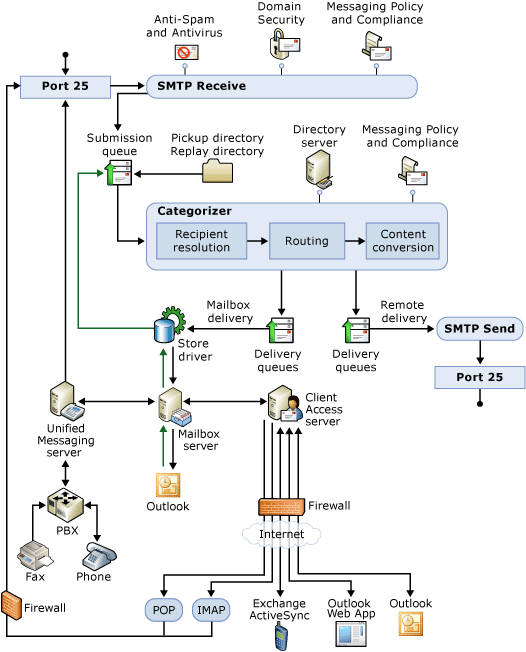Applies to: Exchange Server 2010 SP3, Exchange Server 2010 SP2
Topic Last Modified: 2011-04-28
In Microsoft Exchange Server 2010, the transport pipeline is a collection of Exchange 2010 server roles, connections, components, and queues that work together to route all messages to the categorizer on a Hub Transport server inside the organization. Messages from outside the organization enter the transport pipeline through a Receive connector on an Edge Transport server and are then routed to a Hub Transport server inside the organization. Messages inside the organization enter the transport pipeline on a Hub Transport server in one of the following ways:
- Through a Receive connector
- From the Pickup directory or the Replay directory
- By direct placement in the Submission queue by the store
driver
- Through agent submission
Every message that's sent or received by an Exchange 2010 client must be categorized on a Hub Transport server before it can be routed and delivered. After a message has been categorized, it's put in a delivery queue for delivery to a mailbox in the same Active Directory site as the Hub Transport server on which the message was categorized or for routing to a recipient in a different Active Directory site or forest, or to a recipient outside the organization.
The Exchange 2010 transport pipeline consists of the following components and processes:
- SMTP Receive When messages are received
at the Edge Transport server, anti-spam and antivirus agents filter
connections and message contents, and help identify the sender and
the recipient of a message while the message is being accepted into
the organization. When messages are received at a Hub Transport
server, transport rules are applied and, if anti-spam and antivirus
agents are configured, these agents provide an additional layer of
anti-spam and antivirus protection.
The SMTP session has a series of events that work together in a specific order to validate the contents of a message before it's accepted into the organization. After a message has passed completely through SMTP Receive and isn't rejected by receive events or by an anti-spam and antivirus agent, it's put in the Submission queue.
- Submission Submission is the process of
putting messages into the Submission queue. The categorizer picks
up one message at a time for categorization. There are four types
of submission:
- SMTP submission through a Receive connector.
- Submission through the Pickup directory or the Replay
directory. These directories exist on the Hub Transport server or
Edge Transport server. Correctly formatted message files that are
copied into the Pickup directory or the Replay directory are put
directly into the Submission queue.
- Submission by the store driver, which picks up messages from a
sender’s Outbox as they're sent.
- Submission by an agent.
- SMTP submission through a Receive connector.
- Categorizer The categorizer picks up
one message at a time from the Submission queue. On the Edge
Transport server, categorization is a short process in which the
message is put directly in the delivery queue. From the delivery
queue, the message is routed to a computer that's running a Hub
Transport server role in the organization.
On the Hub Transport server, the categorizer completes the following steps:
- Recipient resolution, which includes top-level addressing,
expansion, and bifurcation
- Routing resolution
- Content conversion
- Recipient resolution, which includes top-level addressing,
expansion, and bifurcation
- Local Delivery Only messages that are
sent to a recipient with a mailbox in the same Active Directory
site as the Hub Transport server on which categorization occurred
are delivered locally. In this case, local delivery means delivery
in the same Active Directory site. All messages delivered locally
are picked up from a delivery queue by the store driver and put in
the recipient’s inbox on a Mailbox server.
- SMTP Send Messages that are sent to
recipients in Active Directory sites that differ from the computer
that's running a Hub Transport server role on which categorization
occurred are delivered remotely or outside the organization. All
messages that are sent to a different Active Directory site, to a
mailbox that resides on a computer that's running an earlier
version of Exchange, or to a mailbox that resides in a different
Active Directory forest must be routed through a Send connector to
a Hub Transport server that can deliver the message to the intended
recipient. All messages that require delivery through the Internet
must be routed through a Send connector to an Edge Transport server
that can send messages to the Internet for delivery outside the
organization.
- Client Access and Unified Messaging
Scenarios Several client access scenarios and
Unified Messaging scenarios don't interact directly with the
transport pipeline. Users of Microsoft Outlook 2007, Outlook
2003, Outlook Web App, Outlook Voice Access, and Exchange
ActiveSync interact directly with the Client Access server role,
Unified Messaging server role, and Mailbox server role to access
their mailbox. In each case, when mail is sent, the message is put
in the sender’s Outbox directly on the Mailbox server by Outlook or
the Client Access server on behalf of the sender.
After the message is put in the sender’s Outbox, the store driver is alerted by the Microsoft Exchange Mail Submission service, which retrieves the message from the sender’s Outbox, and then puts it into the Submission queue on a Hub Transport server in the same Active Directory site as the mailbox from which the message was retrieved. Note:
Note:Outlook Voice Access requires interaction with the Client Access server and with the Mailbox server through the Unified Messaging server.
The following figure shows the relationships among the components in the Exchange 2010 transport pipeline.

Looking for management tasks related to managing transport servers? See Managing Transport Servers.

